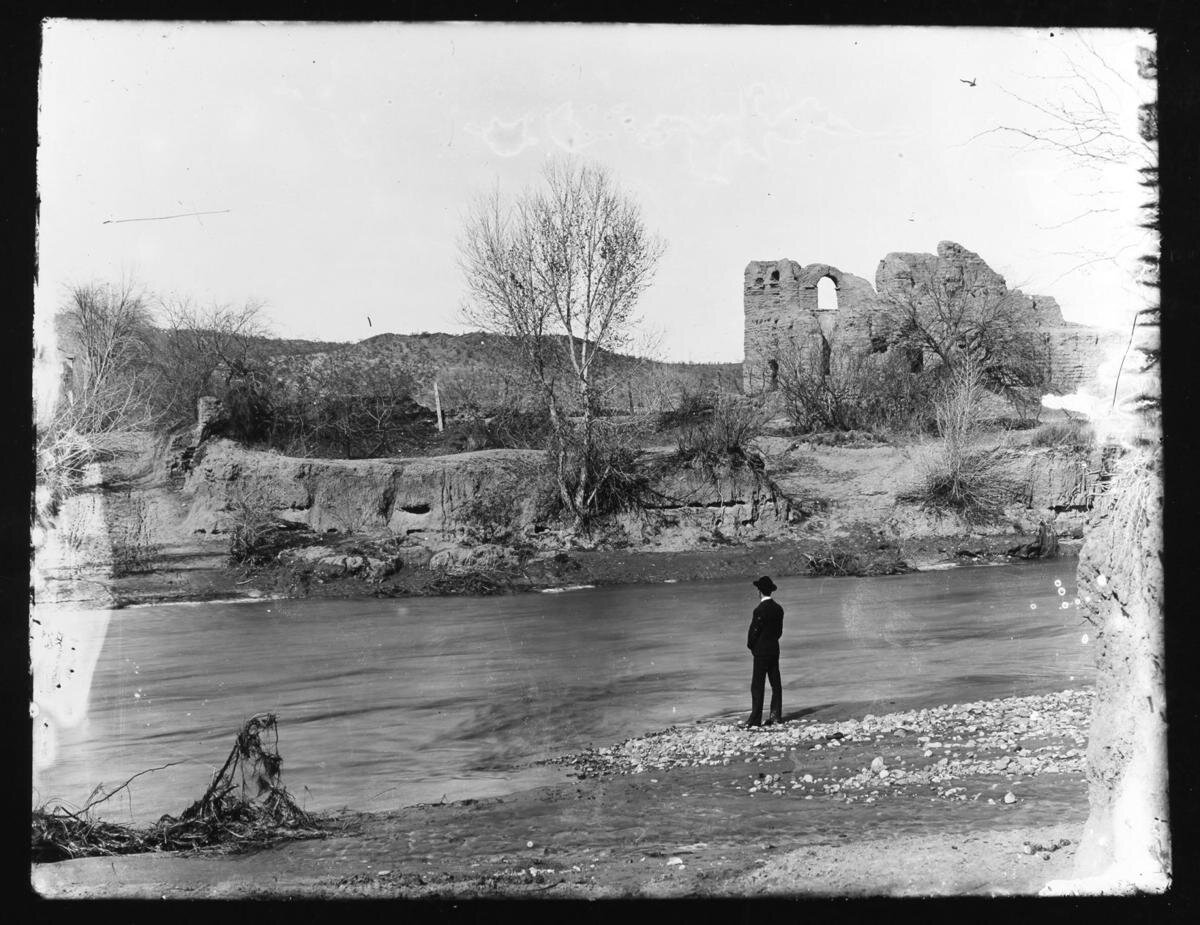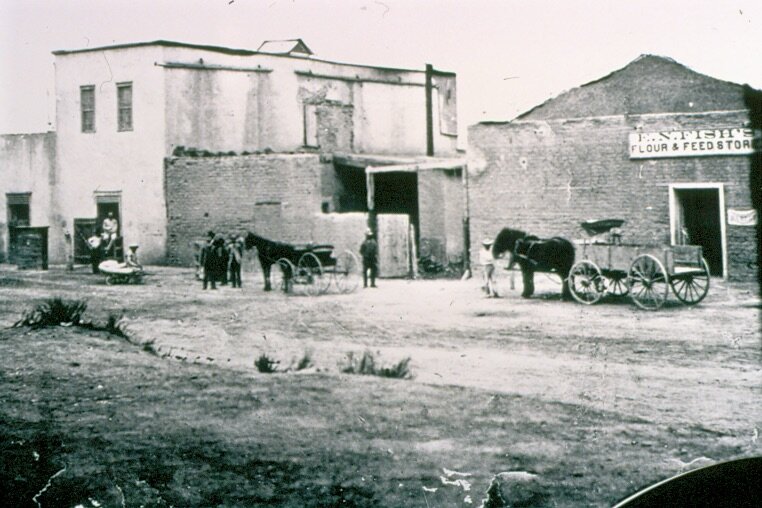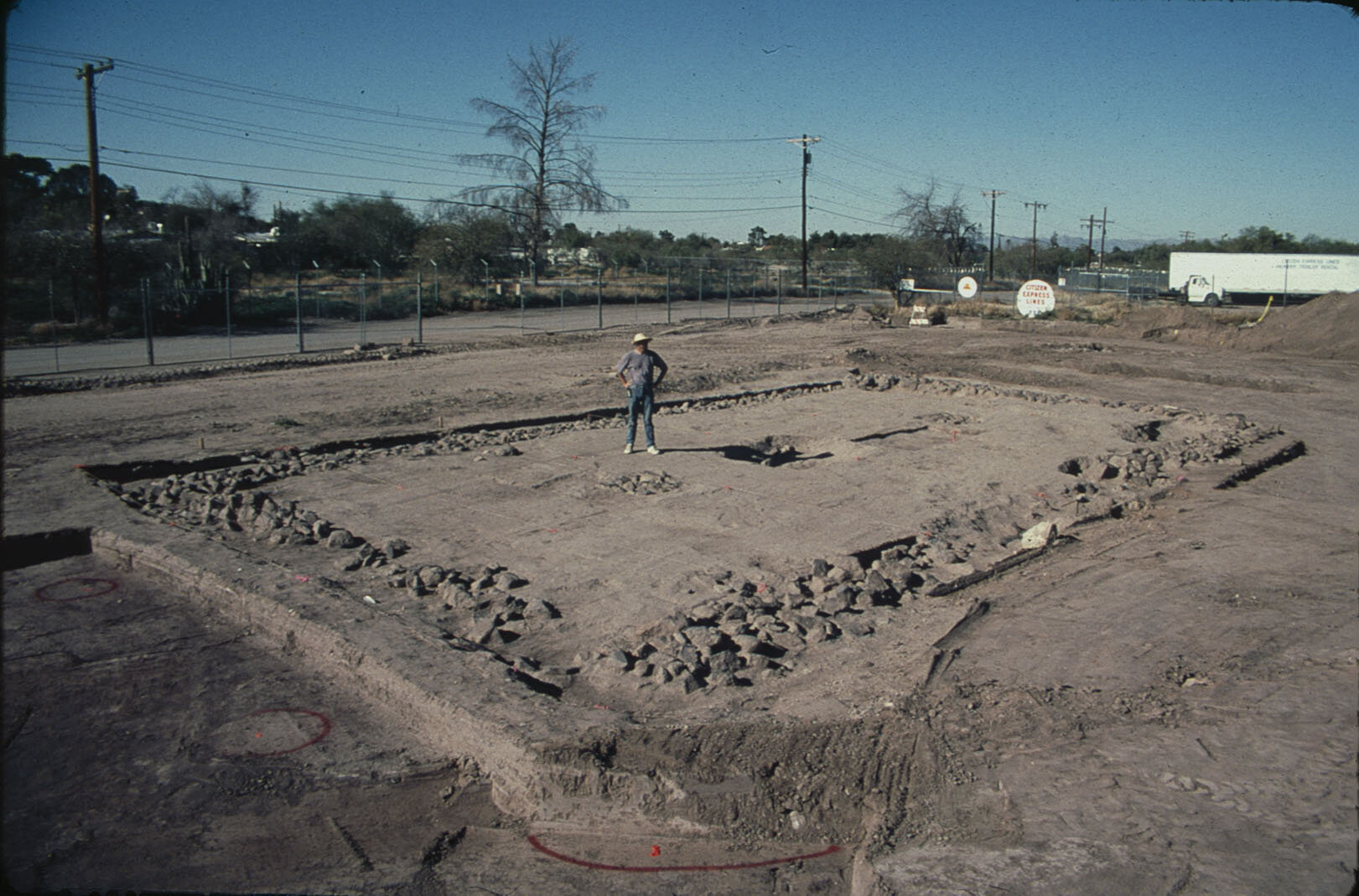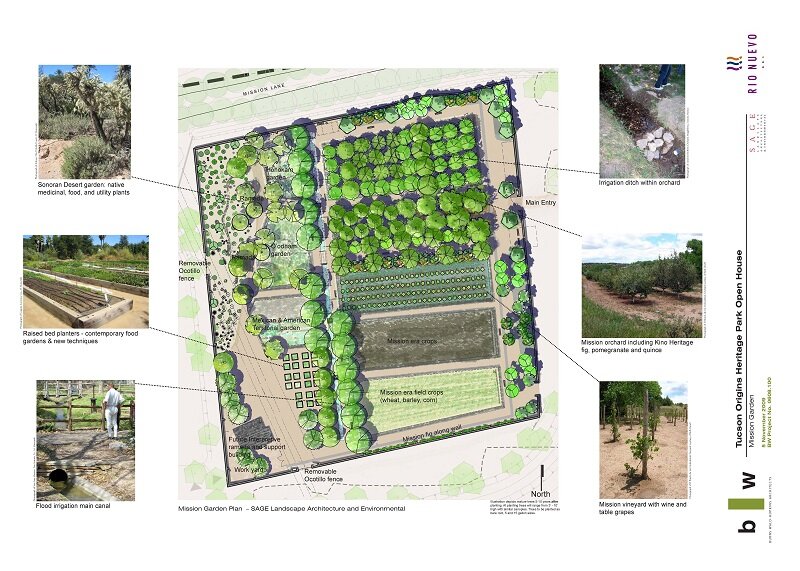
Site History
4000 years of continuous cultivation in the Tucson Basin
Past
The area surrounding Sentinel Peak (‘A’ Mountain) is one of the longest known areas of continuous cultivation in the United States. Including the oldest known canal-irrigated agriculture in the United States (starting at least 3,500 years ago) and stewarded by the Tohono O’odham people.
Present
Mission Garden is a project led by the Friends of Tucson’s Birthplace (FOTB), a 501(c)3 non-profit organization. Current garden plots include: Native Plants, Early Agriculture, Hohokam, O’odham Before European Contact, O’odham After European Contact, Spanish, Mexican, Chinese, Yoeme, Africa in the Americas, Medicinal, and Youth. Areas in development include the Grassland, Territorial, Statehood and Tomorrow’s gardens, as well as the Trail of Ndé (Apache) Plants.
Future
FOTB advocates for building the entire park including the final half acre. Community outreach will expand adding additional events interpreting history and food production, and festivals highlighting specific crops and how to use them, reconnecting people with locally-adapted, small-scale food production, and their own specific tradition of food production, whether it be Native American, Mexican-American, African-American, or other. If you are interested in supporting the future of Mission Garden, consider making a gift.
Timeline
Paleo-Indian: 11,500 – 7,500 BC
Small groups of people moved around over wide areas gathering plants and hunting game, including big game such as mammoths. Evidence exists of these people in the general region but there’s little direct evidence in Tucson. Climate in the region was wetter and cooler than today.
Archaic: 8,500 – 2,100 BC
Climate became warmer and drier, like it is today. Groups of people foraged seasonally over smaller territories. They continued to gather a variety of plants and hunt large and small game. People used grinding tools to process seeds for food.
Early Agriculture: 2,100 BC – AD 50
People in the Tucson Basin began to cultivate maize, a domesticated corn that originated in Mesoamerica. They continued to eat wild resources. In time, people were living in substantial agricultural settlements in the Santa Cruz River floodplain. They built canal systems to water their fields. Dwellings were pithouses, and some settlements also had a larger pit structure that may have served some communal purpose. Earlier than in other areas of the Southwest, the bow-and-arrow began to be used in southern Arizona alongside the older spear thrower and dart.
Early Ceramic: AD 50 – 500
By this time people were using pottery regularly. They built more substantial buildings, and had become more sedentary, living in the same place most or all of the year. Dependence on crops increased—farmers had added beans, squash, cotton and agave. Population increased, canal systems expanded, and trade networks widened.
Hohokam: AD 500 – 1450
Hohokam Pre-classic period, AD 500-1150
Red-on-brown painted pottery became common. Villages had formalized courtyard groups organized into village segments, with roasting areas and cemeteries. Cremation became customary. At first, villages were along the Santa Cruz River. Around 750, people built larger villages along the river and its tributaries. Some villages had ball courts. After AD 950, settlements reached into the foothills. The largest villages remained on terraces above the Santa Cruz River.
Hohokam Classic period, AD 1150 – 1450
Above ground adobe structures and platform mounds were added to villages, though ball courts were abandoned. There were special structures on the platforms where ceremonies may have happened. Agave cultivation appeared to reach its apex.
Protohistoric: AD 1450 – 1692
Hohokam cultural traits and construction disappeared. Smaller scale society predominated and left fewer traces than their predecessors. Residents of the area were probably the O’odham people who experienced the arrival of Spanish colonists in the 1690s (called Papago by the Spanish). Apache people also arrived in the area in the late 1600s.
Spanish Colonial period: AD 1692 – 1821
1692– 1700. As part of the ongoing settlement of New Spain, Father Kino, a Jesuit, and other colonists encountered O’odham villages along the Santa Cruz River. They stretched from what is now San Xavier to the confluence with the Rillito. Kino founded missions at Bac (San Xavier) and at S-cuk ?on. Father Kino wrote down the name of the latter place as “Tucson.” It meant “black base” or “at the base of the black,” referring to the dark volcanic rock of Sentinel Peak (“A” Mountain). The mission at S-cuk ?on eventually became known as San Agustín.
1700 – 1750
The early 1700s saw a series of priests living at San Xavier and visiting San Agustín. San Agustín was therefore called a visita. Population declined during this time, and Jesuit missionaries had little success. In 1751 the first chapel at San Agustin was built. Also in 1751 there was a Pima Uprising. In 1752, a Spanish presidio (fort) was built at Tubac. In 1757, Father Middendorf was resident at San Agustín for only a few months. He left because of malaria and Apache attacks.
1750 – 1785
In 1767, Jesuits were expelled from New Spain. Franciscans replaced them at least at some locations. There were repeated Apache raids in the 1760s and 1770s. In 1775, the Anza expedition passed through the area. The same year the presidio at Tucson was founded, and the presidio at Tubac moved to Tucson in 1776. Construction of the presidio lasted from 1775 to 1777. Its location was on the east bank of the Santa Cruz River, in what’s now downtown Tucson. https://tucsonpresidio.com/HistoryOriginalPresidio. It’s not clear when construction began on the garden wall, but in 1770 “breastworks with gunports” were constructed, in 1771 a priest’s quarters was constructed, in 1772 the chapel was built, in 1773 a walled “mission house” was built, and in 1774 (or so) a granary was built. 1782 saw the biggest Apache attack on Tucson.
1785 – 1800
Construction of church at Bac (which became San Xavier del Bac). 1790s saw construction surge at Mission San Agustin, with construction of the casa conventual (convento) and granary, and reconstruction of the chapel. Ak Chin Pimas and peaceable Apaches from Aravaipa settled in Tucson and helped with construction. The mission had orchards, tanning vats, a soap factory, a blacksmith shop, and a smelter and arrastra (ore crusher) for processing ore. In 1797 the First Mission chapel in poor condition, new church started. After San Xavier was completed, workers “moved to San Agustín and built a two-story convento (a priest’s residence and possibly a trade school), a chapel, a granary, cemetery areas, and a surrounding compound wall.” In 1800 the second chapel was completed.
1800 – 1821
Early in this period, Tucson had 1,015 inhabitants and its residents produced 2,800 bushels of wheat, 3,500 cattle and 1,200 horses. More peaceful Apaches came to Tucson. At the end of this period, the region became a part of Mexico, after a protracted war that started with a revolt in central Mexico in 1810.
Mexican Period AD 1821 – 1856
1827 Spaniards (including Franciscan missionaries) expelled from Mexico
1834 “Secularization” of all missions in Mexico (religious orders such as Franciscans were removed by the Mexican government)
1846 Mormon Battalion passed through Tucson
1852 John Russell Bartlett visits Tucson for US/Mexico Boundary Survey and paints the first image of Mission San Agustín.
1846-48 Mexican American War results in much of northern Mexico becoming territories of the U.S., but not the Tucson area—border was at the Gila River.
1854 Gadsden Purchase results in our region becoming a territory of the U.S.
Territorial Period AD 1856 – 1912
1856 Mexican troops leave presidio of Tucson
1859-60 Catholic church re-established in Tucson
1862 U.S. Army Major David Ferguson draws a map of Tucson agricultural fields, Mission, Mission Garden
1866 US Army establishes Camp Lowell
1869 Leopoldo Carrillo begins constructing house across Mission Lane using some of the convento building materials.
1870 Tucson’s population is 3,000
1875-99 Solomon Warner’s mill in operation
1880s Treasure hunters loot the decaying convento building
1880s Chinese gardeners live in the Carrillo House while growing a variety of vegetables and fruits.
—> Dig deeper: Read the article Lee Wee Kwon Chinese Grocer in Tucson 1917-1965 by Li Yang found in the Journal of Arizona History.
1887 Major earthquake in Sonora affects Tucson’s water table
1889-90 Flooding into Sam Hughes’s canal starts downcutting of Santa Cruz River
1890s Tucson Pressed Brick factory begins operations, digs “borrow pits” (excavations of clay soil used in bricks) near former Mission San Agustin
1907 Transition to residential housing begins on the floodplain
Statehood Period AD 1912 – current
1930s Farming by Chinese gardeners, which had started in the 1870s, ends
1956 Last remains of the convento were bulldozed onto the landfill (trash dump) that was filling brick factory borrow pits at this time
1986 Neighborhood protest stops construction of road through mission site
1999 Rio Nuevo legislation approved by Tucson voters. Voters approved the creation of the Rio Nuevo Multipurpose Facilities District. This was both a municipal stadium district and a special taxing district. The Rio Nuevo District allows the retention of a portion of the sales taxes normally collected in the District to be retained for use in the District, rather than going to the State. District purposes: a planned multi-faceted development project, including cultural and recreational amenities and improvements, unique historic re-creations, mixed-use developments, etc.
2000 – 2003
Initial archaeological work in the Mercado District, brickyard, mission and mission garden area
2003 Through Rio Nuevo funding, a group of consultants hired by the WLB Group created a conceptual plan for Tucson Origins Heritage Park.
2006-8 Final plan, including building blueprints, etc., was created by a team under consultant Burns Wald-Hopkins Shambach Architects. The park included rebuilding S-cuk ?on (Native American village), Mission San Agustin, Mission Garden, Carrillo House and other interpretive areas.
2006-08
Based on newly approved masterplan, Desert Archaeology did additional excavations to clear for construction, including at the Mission Garden and Mission sites.
2007-08 Interpretive plans for Tucson Origins Heritage Park developed.
2008 Construction on the Mission site begins with removal of the landfill and installation of underground utilities. Construction of Mission Garden begins, Construction stops in 2008 due to the economic downturn. Garden was graded, walls and exhibit building were built, but there was no water or landscaping.
2009 – 11 The garden sat empty as a group of long-time advocates for the park formed the non-profit FOTB. FOTB got permission to operate the garden, and they raised funds to further develop it.
2011 FOTB and Pima County enter 5-year development, operations, and maintenance agreement. The garden receives its first Arizona State Forestry Grant. First volunteer work on cleaning orchard. Water lines enter garden.
2012 Irrigation was installed, and planting of the orchard and vineyard was started with Kino Heritage Fruit Trees and grapes in what is now called the Spanish Colonial Orchard. Some ramadas were built, and the first plantings went into the Spanish Colonial Vegetable Garden. Some native trees were planted in the Timeline Garden area. Soil was amended in the Early Agriculture and Hohokam garden areas.
2013 First plantings go in in the Early Agriculture and Hohokam areas. Native plants planted in Z’s Garden (named for Nancy Zierenberg of the Arizona Native Plant Society). Grants from Arizona Forestry Department and the Tohono O’odham helped fund early plantings.
2015 Rio Nuevo funds $1.1M for completion of Mission Garden.
2016 Tarahumara Granary and Chicken Coop assembled. They had been bought in 1978 by the Arizona State Museum for an exhibit on the Tarahumara, and then stored in the State Museum’s basement. In August construction began on the Education Building (the one by the service entrance) and the Kitchen building. (The Exhibit Room walls, the building in the wall by the visitor gate, was built in 2008 when the wall was built, and the roof installed by volunteers in 2012.)
2017 FOTB and Pima County extend their Operating Agreement for an additional five years. Construction of buildings completed in February.
2018 Kitchen outfitted and complete, begins to be used. Mexican and Chinese Gardens inaugurated.
2019 Acequia construction complete and it is filled with water in April.
2020 Creation of the Bookworm Path, which contain books and activities related to each aspect of the garden and aligned to K-12 educational standards. FOTB receives a Partner Capacity-Building Grant from the Community Food Bank of Southern Arizona to to assist with the further organization of 21st Century operations and systems at Mission Garden including Diversity, Equity and Inclusion training, support of the new Heritage Foods Outreach Coordinator, and the update of the Mission Garden Website.
Do you have an edit or suggestion to make to our Timeline?
Please reach out to share it with our team.


























